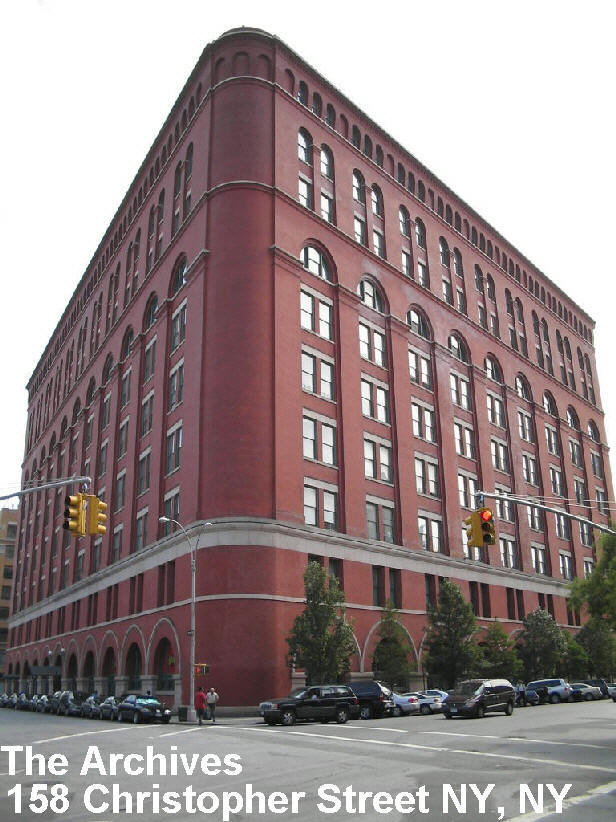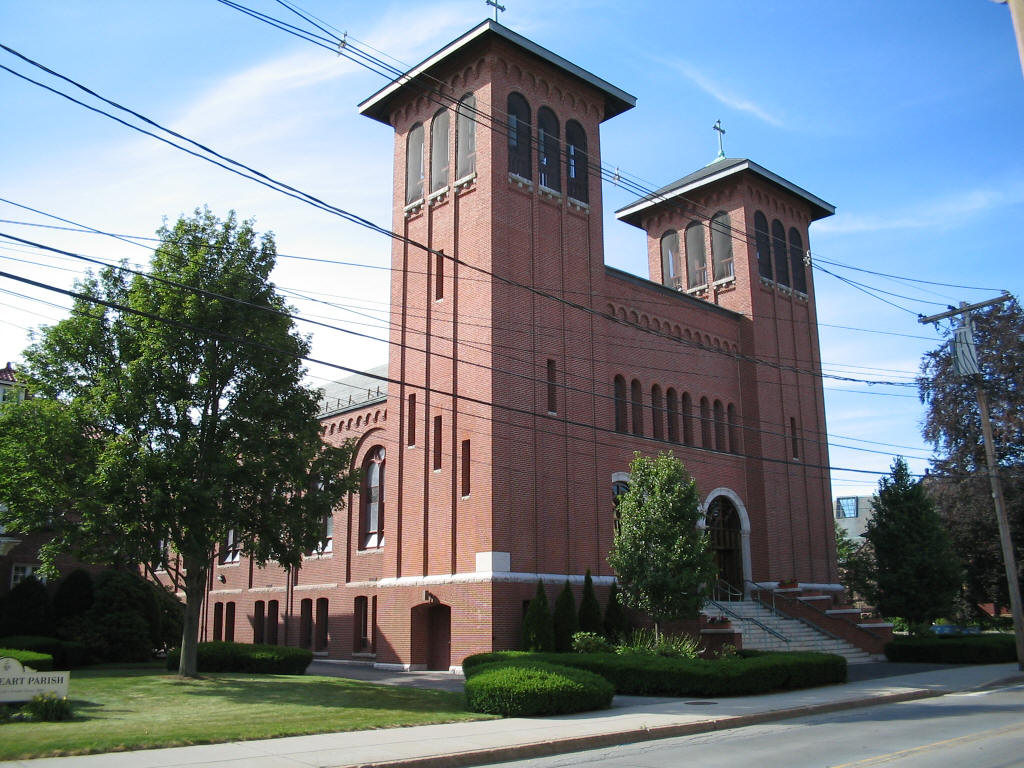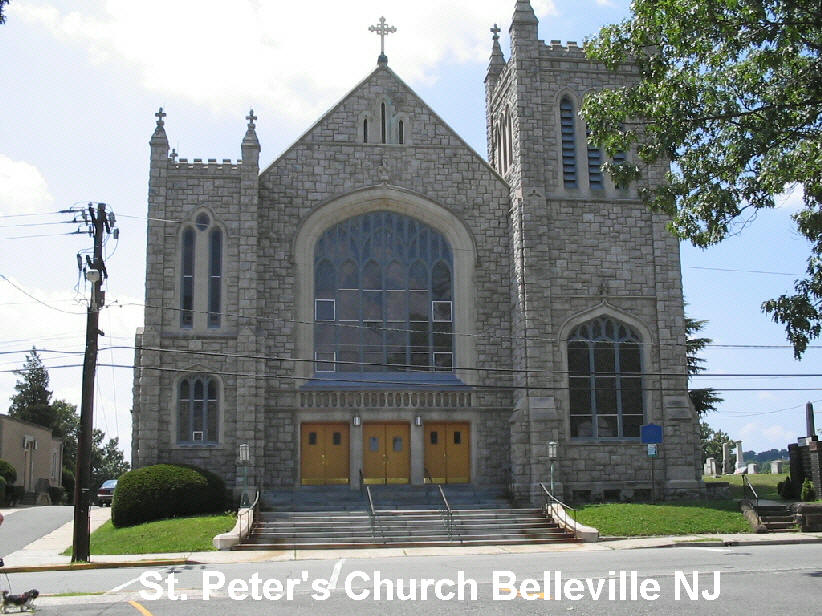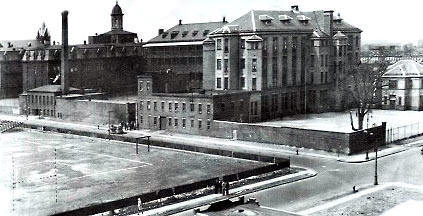









New York City
New York Lives
The banner picture is dedicateded to the 2,977 New York, New Jersey, and Connecticut Americans who went to work at the World Trade Center on the morning of September 11 2001 and the special responders who rushed toward danger to save them. The original photo was taken on Saturday September 15 2001 four days after the attack on America on the Brooklyn Promenade at Clark Street. The tall spire at the center of the photograph is the Woolworth Building and the South Tower wold have been just behind it. The top half of the photo is the original combined with a styleized inverted flip creating a reflection.
Christopher Sullivan originally landed in the Port of Boston in 1885 but it is unclear just how long he stayed there. It is clear that by January of 1889 he was living at 788 Washington Street on the west side of Manhattan, NY as verified by his Declaration of Intent to become a citizen of the United States. The area today bears little resemblance to the gritty assemblage of warehouses bars and boarding houses of the late 1880's. At the time the tracks of the New York Central Railroad ran down the street and there were numerous collisions resulting in many fatalities. Because of this, Tenth Avenue became known as the "Avenue of Death". By the 1930's Robert Moses, in an attempt to reduce the public threat, decided to push for an alternative to the grade level tracks by elevating them above the street level. The building at 788 Washington was directly in the path of the new project, and it was demolished. The tracks were designed to run directly through the warehouses and factories, and many of the buildings that were occupied by companies like Swift Co. and Nabisco still stand today.
The original elevated structure ran from the rail yards at 34th Street down to St John's Park Terminal, the area near Spring Street. The new railroad however, never achieved the purpose to which it was designed and by the 1950's it fell into disuse. As part of an urban renewal plan in the early 1960's the tracks between Spring Street and Gansevoort Street were demolished. At the present site of what was 788 Washington Street stands the modern Condo pictured below left.
 A little over two years later on March 11, 1891
Christopher Sullivan appeared before a Superior Court Judge and petitioned the
court to become a citizen of the United States. On the
Petition for Naturalization
his address is listed as 158 Christopher Street another
A little over two years later on March 11, 1891
Christopher Sullivan appeared before a Superior Court Judge and petitioned the
court to become a citizen of the United States. On the
Petition for Naturalization
his address is listed as 158 Christopher Street another
 site where he would not
remain for very long because that address was also destined for great changes.
By the end of 1894 that address and many of the buildings around it had been
demolished to make way for the The Customs Warehouse a storage for imports
awaiting inspection by customs officers. Later the building was designated as a
storage facility for the US Federal Archives and became known as The Public Archive
Building "The Archives", as it is
now known is an impressive building and it still stands at the foot of
Christopher Street although it has not been used to store records since the
1980's when it was converted into condominiums.
The picture to the lower right was taken in 2003, and clearly shows why this
beautiful building has been granted landmark status.
site where he would not
remain for very long because that address was also destined for great changes.
By the end of 1894 that address and many of the buildings around it had been
demolished to make way for the The Customs Warehouse a storage for imports
awaiting inspection by customs officers. Later the building was designated as a
storage facility for the US Federal Archives and became known as The Public Archive
Building "The Archives", as it is
now known is an impressive building and it still stands at the foot of
Christopher Street although it has not been used to store records since the
1980's when it was converted into condominiums.
The picture to the lower right was taken in 2003, and clearly shows why this
beautiful building has been granted landmark status.
On September 5, 1894 Christopher James Sullivan and Catherine Marie O'Donnell were married in Sacred Heart Church Newton Center (below), Massachusetts and by that time it is clear from the marriage record that Christopher has now moved to Long Island City, NY. Long Island City, in Queens County (not yet a part of New York City) is a busy manufacturing and food distribution center along the East River Estuary which served the City of New York (Manhattan ) across the river.
Long Island City, NY 1894 - 1898
One of those businesses relatively new to the the area was begun in 1883 by brothers Benjamin and Robert Moore, who immigrated to the United States from Ireland. The Benjamin Moore Company was one of the many paint retailers that occupied space just across the bridge in neighboring Brooklyn, but before long they began to distinguish themselves by providing quality products for the rapidly growing population of the City of New York. Although I have never been able to substantiate that Christopher was an employee, I have good reason to believe that he was. More on that later.
William Joseph Sullivan was born on June 18, 1895 in a small Long Island City apartment located at 68 7th Street (below left) just west of Vernon Boulevard. I had great difficulty finding where Bill and his sister Mary Agnes Sullivan were born until I finally got a break in 2003. While researching my Uncle Bill's draft registration card for World War 1, I noticed that it listed his place of birth as Long Island City. I already knew that he was born in 1895 and she in 1897, so from there it was easy to find their birth certificates in the Long Island City birth records.
Mary Sullivan was born in the building just around the corner at number 119 Vernon Avenue (photo right).
The one thing that I always found consistent about tracking the whereabouts of the Sullivan family is that they always lived within close proximity to the neighborhood Catholic Church, in this case St Mary's Long Island City (below right). Why so important to find the local church? The Sullivan Family were practicing Catholics, and therefore all the children would be baptized according to the rites of the church. Since baptismal records always document who the godparents are it is a great opportunity to uncover the mix of family relationships heretofore unknown. In this case Catherine's sisters Mary and Margaret, and Mary's husband Patrick Mulcahy. The Mulcahy name will appears elsewhere in the family tree and can be found in Vital records.
Of all the places connected with this branch of the Sullivan Family, none plays a more prominent role than the Borough of Brooklyn (Kings County) New York. It is where the family grew and prospered, rose and fell. If they moved (and they did so frequently) it was, with one exception, within the neighborhoods of Park Slope and Sunset Park in Brooklyn. The exact date the family moved there is uncertain, but the first clear evidence is Arthur's birth in November of 1899. the residence is 185 42nd Street in the Sunset Park section of Brooklyn. Finding them was very difficult because oddly enough it seems that both Arthur (1899) and Joseph (1902) have no birth certificate on file at the Municipal Archives. As hard as I tried, I could not find a birth record in any of the 5 Boroughs even taking into the possibility of a clerical error. So another approach would be necessary if I were ever to be successful.
The only other method for locating the family would have to be the Brooklyn Directory list for the years 1897 through 1899 and that proved to be successful. The first listing for Christopher was for 1898, and he was remarkably easy to trace because there were only two or three Christopher Sullivans listed in the entire city. Once I had the address I looked for the closest RC Church and it happened to be directly across the street from their residence. As I stated earlier, never far from the church, in this case the beautiful Church of St Michael's. St. Michael's Church is a prominent fixture on the landscape of Third Avenue Brooklyn, almost directly in line with the Statue of Liberty across Upper New York Harbor. From the baptismal certificates I was able to verify the date of birth for Arthur T Sullivan and Joseph A Sullivan.
Sidestep to Belleville, New Jersey 1902 - 1905
 As I wrote earlier, the family resided in the Brooklyn
neighborhoods of Park Slope and Sunset Park with one exception, and that was a brief
sidestep
to Belleville, New Jersey between the the latter part of 1902 through 1905. It's not clear just why they moved to New Jersey, perhaps it was
because Benjamin Moore had just opened a new paint manufacturing plant, or just
to be closer to his brother Ed who was ailing (Ed's wife Margaret was also
Catherine's sister). My father Edward Sullivan was born in the town of
Belleville, Essex County New Jersey on March 6, 1904 and already there was a
controversy. His
Birth
Certificate indicates that he was named Charles (after Christopher's brother
in Quincy, Massachusetts) but at some point shortly after that, his parents
changed their mind. He was baptised 14 days later in St Peter's RC Church
in Belleville NJ and his
Baptismal Certificate clearly shows that he was christened
Edward Sullivan in honor of his Uncle Ed. I know that later this caused some
problems for my father when he and my mother were planning their wedding in June
of 1943 because he was required to get a sworn affidavit in order to get an
amended certificate from the
State of New Jersey.
As I wrote earlier, the family resided in the Brooklyn
neighborhoods of Park Slope and Sunset Park with one exception, and that was a brief
sidestep
to Belleville, New Jersey between the the latter part of 1902 through 1905. It's not clear just why they moved to New Jersey, perhaps it was
because Benjamin Moore had just opened a new paint manufacturing plant, or just
to be closer to his brother Ed who was ailing (Ed's wife Margaret was also
Catherine's sister). My father Edward Sullivan was born in the town of
Belleville, Essex County New Jersey on March 6, 1904 and already there was a
controversy. His
Birth
Certificate indicates that he was named Charles (after Christopher's brother
in Quincy, Massachusetts) but at some point shortly after that, his parents
changed their mind. He was baptised 14 days later in St Peter's RC Church
in Belleville NJ and his
Baptismal Certificate clearly shows that he was christened
Edward Sullivan in honor of his Uncle Ed. I know that later this caused some
problems for my father when he and my mother were planning their wedding in June
of 1943 because he was required to get a sworn affidavit in order to get an
amended certificate from the
State of New Jersey.
Return to Brooklyn 1905 - 1912
Using the Brooklyn Directory for 1905 the Sullivans appear again in Brooklyn at 184 8th Street in Park Slope (left) joining the parish of St. Thomas Aquinas Church on Ninth Street and Third Ave in Park Slope Brooklyn (below left). The house itself was a relatively small building just off the corner of Third Avenue on a quiet tree lined street. The neighborhood of Park Slope must have been a desirable place for the family because of its proximity to Church, and also the schools which at the time were considered better than average. I have not been able to establish where Christopher worked at the time, but it must have been one of the many factories the predominated the Gowanus region of Brooklyn. By late 1906 Catherine and Christopher were expecting another child, and the small quarters would no longer be sufficient. The family moved for the final time to a new apartment building on the corner of Third Avenue and 16th Street in Park Slope pictured at the lower right.
The building at 586 3rd Avenue is a rather large building, unusual for the time in which it was built around the turn of the last century. The fact that it is still standing at all is a miracle in itself no thanks to Robert Moses again. On two separate occasions the property stood perilously close to destruction, first in the early 1940's when the Gowanus Expressway was constructed over the route of the just demolished 3rd Avenue elevated train, and again in the late 1950's when the extension for the Prospect Expressway was built bisecting Prospect Park West past Pritchard Square and cutting off the area surrounding Greenwood Cemetery. Buildings on the east side of Third Avenue fronting the road were demolished in order to make room for the highway above as well as expanding Third Avenue below the elevated roadway.
It was at 586 3rd Avenue where Margaret Sullivan was born on February 5, 1907, and Paul Sullivan two years later on September 23, 1909 (Also note the obvious error listing the mother's maiden name as Ryan). From the admission records of St John's Home for boys I was able to determine that the children attended nearby PS 40 which was situated almost equally between 3rd and 4th Avenues on 15th Street. The building was constructed sometime in the mid 1880's and by the time the family had moved to that location the facility was hopelessly outdated. Yet somehow it survived until the early 1950's when it was demolished. and replaced with a multifamily dwelling. Life was good here but it was about to take a drastic turn.
In March 1910, at six months of age young Paul developed whooping cough which developed into Pneumonia and taking the life of the infant on April 7. He was buried in the family plot in Calvary Cemetery Middle Village, NY. The family health issues were however were just beginning. Catherine and Christopher were already ill, and the effects of tuberculosis were beginning to take a toll. By the Middle of 1911 Catherine took to her sick bed and became incapacitated, while Christopher struggled to work until he too was unable to continue. During this time the children were looked after by the Feis family and Martha Lehman, Arthur's Godmother.
Christopher Sullivan was committed to St. Peter's Hospital Brooklyn, NY on December 28, 1911 followed by Catherine 11 days later on the 8th day of January. While the end came quickly for Catherine on the following day, Christopher lingered for an additional 42 days before expiring on February 20, 1912. They were buried in Calvary Cemetery in Maspeth, NY, at the same site where their infant son was laid to rest less than two years earlier. The report from the Child Welfare Agency gives insight as to the timeline of events during that period of time. It appears on the forms for Arthur, Joe, and Ed when they were admitted to St. John's Home for Children.
From The Child Welfare Department:
Father is in St. Peter's Hospital. He has not been able to work since October 1911.Mother is also sick (consumptive) and is unable to take care of home or children. There are six children; one is working, earns $4.50 per week. In view of the fact that the family is destitute, and that the mother is not in condition to look after her family, four children were committed by this department and the two oldest will remain at home. There are no relatives able to assist.
St Peter's Hospital Church and School Cobble Hill Brooklyn, NY
The St. Peter's Complex between Warren and Congress Sreets in the Cobble Hill section of Brooklyn, NY. The building in the picture to the left was St. Peter's Hospital from 1889 through 1962 when it closed. Both Christopher and Catherine Sullivan died in this building within 42 days of each other in 1912. In 1964 the hospital was renovated and much of it's landmark facade was removed, much to the dismay of local preservationists. In that same year the former hospital building opened as a senior care facility.
In the picture below, also taken in 2004, the lettering above the main entrance to the old school is still clearly visible above the doorway. The facility was completed in late 2004 and much of the space is sold. St. Peter's School closed in 1962 was sold in the early 1980's to a developer who wished to redevelop the property. The Cobble Hill Society pushed for landmark status for the buildings delaying any plans for for demolishing the school and the church. By 1984 a plan was filed with the city which proposed that the exterior of the property would be maintained in it's preexisting condition, while the interior would be gutted and converted to condominium apartments. The picture above left shows St. Peter's School (left), and the church (right). By the time this picture was taken in 2004, the steeple and all the stained glass windows had been removed. The steel and brick barrier in the foreground is the Brooklyn Queens Expressway which, when it was designed and built by Robert Moses effectively served to isolate the neighborhood of Red Hook from Cobble Hill causing its demise as a desirable working class neighborhood.
St John's Home For Boys Brooklyn, NY
 In 1868 under the care of the Sisters of St Joseph, St. John's Home opened on
the site near Albany and Troy Avenues in Brooklyn, NY. My father and his
two brothers Arthur and Joe were housed in the complex pictured above from 1912
until my father left under the care of his older brother Arthur in 1920.
Although they lost their parents under tragic circumstances, they always spoke
lovingly of the place that was their home during those years. It was probably
the closest they ever came to a childhood.
In 1868 under the care of the Sisters of St Joseph, St. John's Home opened on
the site near Albany and Troy Avenues in Brooklyn, NY. My father and his
two brothers Arthur and Joe were housed in the complex pictured above from 1912
until my father left under the care of his older brother Arthur in 1920.
Although they lost their parents under tragic circumstances, they always spoke
lovingly of the place that was their home during those years. It was probably
the closest they ever came to a childhood.
Picture left: St John's Home for Boys as it appeared around the early 1900's
and in the picture left in 2004. It is now public housing.
By 1954 a new facility was opened in the Rockaway Beach area of Queens County NY and the complex in Brooklyn was closed for good. When the new living facilities were opened in 1970, my Uncle Joe attended a school reunion. Needless to say he was thrilled to see some of his old buddies again. Although the times have changed, St John's Home For Boys continues on it's mission to care for disadvantaged children, preparing them for their entrance into society.